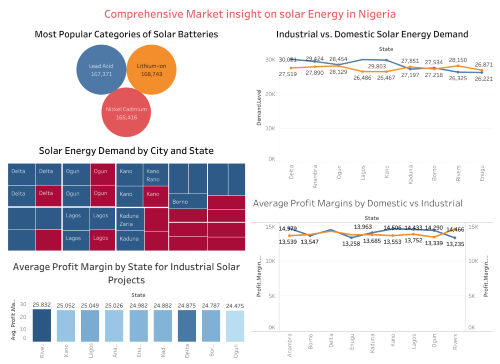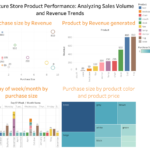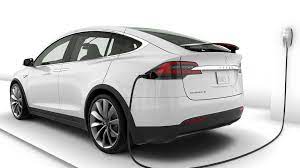Analysis of Solar Energy Demand and Profitability in Nigeria

Analysis of Solar Energy Demand and Profitability in Nigeria? As the need for renewable energy grows across the globe, Nigeria has seen a significant rise in the demand for solar energy, driven by the country’s persistent energy supply challenges. This report aims to provide a comprehensive analysis of the solar energy market in Nigeria, with a specific focus on identifying the states with the highest demand for solar energy and pinpointing the cities within these regions that exhibit the most interest in solar solutions. In addition to geographic demand, the analysis will explore the types of solar batteries and panel sizes that are most favored by consumers, offering insight into product preferences that drive the market.
Furthermore, the report delves into the financial side of solar energy, analyzing the profit margins for contractors involved in industrial solar projects and comparing the demand between industrial and domestic solar installations. The analysis also examines the variance in demand between new and used solar panels, providing a clearer picture of consumer behavior in this growing sector. Lastly, the study will explore the future outlook for mini solar grids in Nigeria, shedding light on the potential expansion of this technology as the country moves toward more decentralized and sustainable energy solutions.
2.0 Some assumption
Here are four possible assumptions for the analysis based on the topic “Analysis of Solar Energy Demand and Profitability in Nigeria”:
2.1 Geographical Demand Concentration
It is assumed that the demand for solar energy is higher in urbanized and economically developed states such as Lagos, Abuja, and Rivers compared to less urbanized regions. Within these states, major cities are expected to show the most interest in solar solutions due to higher energy needs and frequent power supply issues.
2.2 Product Preference
It is assumed that there is a preference for larger solar panels (e.g., 500 watts and above) among industrial consumers, while domestic consumers prefer smaller panels. Additionally, certain types of solar batteries, particularly lithium-ion batteries, are expected to have higher patronage due to their efficiency and longer lifespan compared to lead-acid batteries.
2.3 Profitability of Industrial Solar Projects
It is assumed that the profit margins for solar contractors involved in industrial solar projects are significantly higher than those dealing with domestic installations, owing to larger-scale operations, higher capital investment, and greater demand for industrial energy solutions in sectors like manufacturing and telecommunications.
2.4 Preference for New Solar Panels
It is assumed that new solar panels are in higher demand compared to used solar panels due to concerns over the efficiency and durability of used equipment. However, there may be a niche market for used panels in lower-income areas or among consumers looking for cost-effective solutions.
3.0 Questions to answer
Here are six key questions that can be used for analysis based on the provided statements of inquiry:
3.1 Which states in Nigeria have the highest demand for solar energy, and which cities within these states exhibit the greatest demand for solar solutions?
3.2 What are the most popular categories of solar batteries in terms of patronage, and which sizes of solar panels (e.g., 500 watts, 550 watts, etc.) are most in demand in the Nigerian market?
3.3 What is the average profit margin for solar contractors in Nigeria, particularly when focusing on industrial solar energy projects?
3.4 How does the demand for industrial solar energy compare to the demand for domestic solar energy across different regions in Nigeria?
3.5 What is the variation in demand between new and used solar panels, and how do consumer preferences differ between the two options?
3.6 What is the future outlook for mini solar grids in Nigeria, and how is this sector expected to grow in the coming years?
4.0 We shall be producing the report with the following deliverables:
1 A clear summary of the business task
2 A description of all data sources used
3 Documentation of any cleaning or manipulation of data
4 A summary of your analysis
5 Supporting visualizations and key findings
6 Your top high-level content recommendations based on your analysis
5.0 In order to answer the key questions, I will follow the steps of the data analysis process of ask, prepare, process, analyze, share, and act as a guide to answering this question
6.0 Phase : Ask
6.1 What is the problem you are trying to solve?
Understanding the patterns of solar energy demand across different states and the cities within these states in Nigeria and evaluating the profitability of solar energy solutions for contractors.
6.2 How can insights gotten drive business decisions?
Insights derived from the solar energy dataset can significantly influence or drive business decisions in several key areas. By identifying the states and cities with the highest demand for solar energy, businesses can focus their marketing, sales, and distribution efforts on these lucrative regions, ensuring effective resource allocation. Understanding the most popular types of solar batteries and panel sizes allows companies to optimize their product offerings, aligning inventory and marketing with consumer preferences. Profitability insights, particularly for contractors working with industrial solar energy, help refine pricing strategies to maximize profits while staying competitive. Additionally, distinguishing between industrial and domestic demand enables businesses to tailor solutions to each segment’s unique needs, resulting in more targeted product development. Insights into the demand for new versus used solar panels can further guide inventory management, reducing overstock risks for less popular products. Lastly, projections for the future of mini solar grids can help companies make strategic investments in emerging markets, positioning themselves for growth in this expanding sector.
6.3 identify the business task
The business task is to analyze solar energy demand, product preferences, profitability, and market trends in Nigeria to guide strategic decisions on marketing, product offerings, pricing, and investments.
6.4 Consider key stakeholders
1.The managing director
2.The brand manager
3 Marketing analytics team
6.5 The product: All the solar
Solar energy encompasses a diverse range of products and technologies designed to harness sunlight for various applications, including electricity generation, heating, and powering devices. Key categories include:
- Solar Panels and Modules
Photovoltaic (PV) Panels: These devices convert sunlight directly into electricity and are fundamental to both residential and commercial solar energy systems. WIKIPEDIA
Concentrated Solar Power (CSP) Systems: Utilizing mirrors or lenses, CSP systems focus sunlight onto a small area to produce intense heat, which is transformed into electricity. WIKIPEDIA
- Solar Batteries and Storage Solutions
Lithium-ion Batteries: Renowned for their efficiency and longevity, these batteries are commonly used to store energy in solar installations.
Lead-acid Batteries: An older technology that remains in use for solar energy storage, though less efficient than lithium-ion alternatives.
- Solar Thermal Collectors
Solar Water Heaters: Devices that capture sunlight to heat water for domestic or commercial use.
Solar Air Heaters: Systems designed to warm air using solar energy, typically employed for space heating.
- Solar-Powered Devices
Solar Chargers: Portable devices that use solar panels to recharge batteries or power electronic gadgets.
Solar Lighting: Includes products like solar-powered streetlights and garden lights, which utilize solar energy to provide illumination.
Solar-Powered Vehicles: Transportation modes, such as cars and buses, that are powered by solar energy. ENERGYSAGE
- Mini Solar Grids
Standalone Systems: Small-scale solar installations that provide electricity to remote or off-grid areas.
Community Solar Projects: Shared solar arrays that multiple households or businesses can access, promoting collective investment in solar infrastructure. ENERGY.GOV
Advancements in solar technology have led to innovative products like solar-powered backpacks, which integrate solar panels to charge devices on the go, catering to the needs of travelers and outdoor enthusiasts. LIFEWIRE
The declining costs of solar panels have significantly propelled global adoption, making solar energy an increasingly vital component of the energy mix in many regions.
7.0 Phase 2: prepare
7.1 Where is your data stored?
The dataset is saved in a csv file, in an excel and The data is on solar energy dataset in Public Domain, dataset made available through AI
7.2 How is the data organized? Is it in long or wide format?
The data set contains a single CSV file organized in long format.
7.3 Are there issues with bias or credibility in this data? Does your data ROCCC?
Taking the data through the ROCCC,i can say that they are limitations and bias with the data as it only contian a file of about 1233kb
7.4 ROCCC analysis
- Reliable — LOW — Not reliable as it only has a single file.
- Original — LOW — Third party provider (AI generated)
- Comprehensive — MED — Parameters did cover most parameters
- Current — LOW — Data is 5 years old and may not be relevant now
- Cited — LOW — Data collected from third party, hence unknown
The dataset is considered bad quality data in all as it does not meet the ROCCC requirement hence it can an inight and recommended to produce business recommendations based on this data.
7.5 How are you addressing licensing, privacy, security, and accessibility?
Since it is a public data, there is no issure with licensing, privacy, security, and accessibility of the dataset
7.6 How did you verify the data’s integrity?
Due to the fact that the data is collected via AI generated, we are cannot ascertain its integrity or accuracy.
7.7 How does it help you answer your question?
The ROCCC analysis helps determine the credibility, completeness, and reliability of the solar energy dataset, ensuring it is suitable for accurate and informed analysis. By evaluating factors like consistency and originality, it ensures the data can be trusted to answer key business questions related to solar demand, product preferences, and profitability.
7.6 Are there any problems with the data?
Yes, AI-generated data may introduce biases, lack real-world authenticity, and fail to capture actual market dynamics, which can limit its reliability for accurate analysis. Additionally, without verifiable sources, it can be difficult to trust the data’s credibility and consistency for informed business decisions.
8.0 Phase3:Process
We Process the data by cleaning and ensuring that it is correct, relevant, complete and free of error and outline.
8.1 install the needed package
install.packages(“tidyverse”)
install.packages(“lubridate”)
install.packages(“ggplot2”)
install.packages(“skimr”)
install.packages(“janitor”)
install.packages(“readr”)
install.packages(“plyr”)
8.2 Load the needed Library
library(tidyverse)
## ── Attaching core tidyverse packages ──────────────────────── tidyverse 2.0.0 ──
## ✔ dplyr 1.1.4 ✔ readr 2.1.5
## ✔ forcats 1.0.0 ✔ stringr 1.5.1
## ✔ ggplot2 3.5.1 ✔ tibble 3.2.1
## ✔ lubridate 1.9.3 ✔ tidyr 1.3.1
## ✔ purrr 1.0.2
## ── Conflicts ────────────────────────────────────────── tidyverse_conflicts() ──
## ✖ dplyr::filter() masks stats::filter()
## ✖ dplyr::lag() masks stats::lag()
## ℹ Use the conflicted package (<http://conflicted.r-lib.org/>) to force all conflicts to become errors
library(ggplot2)
library(lubridate)
library(skimr)
library(janitor)
##
## Attaching package: ‘janitor’
##
## The following objects are masked from ‘package:stats’:
##
## chisq.test, fisher.test
library(readr)
library(plyr)
## ——————————————————————————
## You have loaded plyr after dplyr – this is likely to cause problems.
## If you need functions from both plyr and dplyr, please load plyr first, then dplyr:
## library(plyr); library(dplyr)
## ——————————————————————————
##
## Attaching package: ‘plyr’
##
## The following objects are masked from ‘package:dplyr’:
##
## arrange, count, desc, failwith, id, mutate, rename, summarise,
## summarize
##
## The following object is masked from ‘package:purrr’:
##
## compact
getwd()
## [1] “C:/Users/ME/Desktop/Factresort material/factreslrt 4 May/factresort for june/CVs and Cover Letter/BI Images/OLISE WORK”
8.3 import/load dataset
library(readr)
solar_energy_power <- read_csv(“C:/Users/ME/Desktop/Factresort material/factreslrt 4 May/factresort for june/CVs and Cover Letter/BI Images/OLISE WORK/solar energy power.csv”)
## Rows: 10000 Columns: 20
## ── Column specification ────────────────────────────────────────────────────────
## Delimiter: “,”
## chr (10): State, City, Battery Category, Solar System Type, Panel Type, Cust…
## dbl (8): Demand Level, Panel Size (W), Profit Margin (%), Sales Volume, Pri…
## lgl (2): Government Subsidy, Mini Grid Growth
##
## ℹ Use `spec()` to retrieve the full column specification for this data.
## ℹ Specify the column types or set `show_col_types = FALSE` to quiet this message.
8.4 creating a dataframe for the dataset
solar_power1 <- data.frame(solar_energy_power)
8.5 WRANGLING OF DATA
Check column names each
colnames(solar_power1)
## [1] “State” “City”
## [3] “Demand.Level” “Battery.Category”
## [5] “Panel.Size..W.” “Solar.System.Type”
## [7] “Panel.Type” “Customer.Type”
## [9] “Profit.Margin….” “Sales.Volume”
## [11] “Price.per.Panel..NGN.” “Installation.Costs..NGN.”
## [13] “Purchase.Date” “Government.Subsidy”
## [15] “Consumer.Income.Level” “Peak.Demand.Season”
## [17] “Supplier.Brand” “Mini.Grid.Growth”
## [19] “Projected.Growth.Rate….” “Installer.Availability”
8.6 clean dataset
tibble::as_tibble(solar_power1)
## # A tibble: 10,000 × 20
## State City Demand.Level Battery.Category Panel.Size..W. Solar.System.Type
## <chr> <chr> <dbl> <chr> <dbl> <chr>
## 1 Delta Sapele 48 Lithium-ion 700 On-grid
## 2 Delta Asaba 67 Nickel Cadmium 700 Off-grid
## 3 Borno Dikwa 34 Lead Acid 500 Off-grid
## 4 Kano Gaya 13 Nickel Cadmium 650 On-grid
## 5 Anambra Nnewi 23 Nickel Cadmium 500 Off-grid
## 6 Ogun Ota 24 Nickel Cadmium 550 On-grid
## 7 Delta Warri 37 Nickel Cadmium 700 Hybrid
## 8 Rivers Omoku 4 Lithium-ion 500 Hybrid
## 9 Lagos Epe 3 Lithium-ion 550 Hybrid
## 10 Ogun Abeok… 25 Nickel Cadmium 700 On-grid
## # ℹ 9,990 more rows
## # ℹ 14 more variables: Panel.Type <chr>, Customer.Type <chr>,
## # Profit.Margin…. <dbl>, Sales.Volume <dbl>, Price.per.Panel..NGN. <dbl>,
## # Installation.Costs..NGN. <dbl>, Purchase.Date <chr>,
## # Government.Subsidy <lgl>, Consumer.Income.Level <chr>,
## # Peak.Demand.Season <chr>, Supplier.Brand <chr>, Mini.Grid.Growth <lgl>,
## # Projected.Growth.Rate…. <dbl>, Installer.Availability <dbl>
8.7 check for structure of the dataset
str(solar_power1)
## ‘data.frame’: 10000 obs. of 20 variables:
## $ State : chr “Delta” “Delta” “Borno” “Kano” …
## $ City : chr “Sapele” “Asaba” “Dikwa” “Gaya” …
## $ Demand.Level : num 48 67 34 13 23 24 37 4 3 25 …
## $ Battery.Category : chr “Lithium-ion” “Nickel Cadmium” “Lead Acid” “Nickel Cadmium” …
## $ Panel.Size..W. : num 700 700 500 650 500 550 700 500 550 700 …
## $ Solar.System.Type : chr “On-grid” “Off-grid” “Off-grid” “On-grid” …
## $ Panel.Type : chr “Used” “Used” “New” “Used” …
## $ Customer.Type : chr “Industrial” “Industrial” “Domestic” “Domestic” …
## $ Profit.Margin…. : num 10.1 21.6 11.3 19.5 21.1 …
## $ Sales.Volume : num 388 312 166 228 189 152 85 160 104 461 …
## $ Price.per.Panel..NGN. : num 136031 178981 119848 275346 189083 …
## $ Installation.Costs..NGN. : num 389536 691621 344850 865004 738625 …
## $ Purchase.Date : chr “3/15/2021” “4/12/2021” “11/6/2020” “9/8/2020” …
## $ Government.Subsidy : logi FALSE FALSE TRUE TRUE TRUE TRUE …
## $ Consumer.Income.Level : chr “Low” “High” “Medium” “High” …
## $ Peak.Demand.Season : chr “Off-peak” “Off-peak” “Off-peak” “Peak” …
## $ Supplier.Brand : chr “Brand B” “Brand C” “Brand B” “Brand A” …
## $ Mini.Grid.Growth : logi FALSE FALSE FALSE FALSE FALSE FALSE …
## $ Projected.Growth.Rate….: num 18.99 6.74 10.35 17.77 13.22 …
## $ Installer.Availability : num 62 43 75 42 26 51 43 43 46 79 …
8.8 Round off the relevant columns to the nearest whole number
solar_power1[] <- lapply(solar_power1, function(x) if(is.numeric(x)) round(x, 0) else x)
#Convert the string to a Date object by specifying the correct format
solar_power1$Purchase.Date <- as.Date(solar_power1$Purchase.Date, format = “%m/%d/%Y”)
#Add columns that list the date, month, day, and year of each ride
solar_power1$month <- format(solar_power1$Purchase.Date, “%B”) # Full month name
solar_power1$Year <- format(solar_power1$Purchase.Date, “%Y”) # Year
9.0 Lets do some descriptive analysis to see some analysis
#Summarize dataset
summary(solar_power1)
## State City Demand.Level Battery.Category
## Length:10000 Length:10000 Min. : 1.00 Length:10000
## Class :character Class :character 1st Qu.: 25.00 Class :character
## Mode :character Mode :character Median : 50.00 Mode :character
## Mean : 50.15
## 3rd Qu.: 75.00
## Max. :100.00
## Panel.Size..W. Solar.System.Type Panel.Type Customer.Type
## Min. :500.0 Length:10000 Length:10000 Length:10000
## 1st Qu.:550.0 Class :character Class :character Class :character
## Median :600.0 Mode :character Mode :character Mode :character
## Mean :598.8
## 3rd Qu.:650.0
## Max. :700.0
## Profit.Margin…. Sales.Volume Price.per.Panel..NGN.
## Min. :10.00 Min. : 1.0 Min. : 50020
## 1st Qu.:18.00 1st Qu.:132.0 1st Qu.:113183
## Median :25.00 Median :253.0 Median :175647
## Mean :25.01 Mean :253.2 Mean :175549
## 3rd Qu.:32.00 3rd Qu.:376.0 3rd Qu.:238825
## Max. :40.00 Max. :500.0 Max. :299994
## Installation.Costs..NGN. Purchase.Date Government.Subsidy
## Min. :100255 Min. :2020-01-01 Mode :logical
## 1st Qu.:327277 1st Qu.:2020-10-09 FALSE:5014
## Median :548553 Median :2021-07-03 TRUE :4986
## Mean :549601 Mean :2021-07-02
## 3rd Qu.:773022 3rd Qu.:2022-03-30
## Max. :999724 Max. :2022-12-30
## Consumer.Income.Level Peak.Demand.Season Supplier.Brand Mini.Grid.Growth
## Length:10000 Length:10000 Length:10000 Mode :logical
## Class :character Class :character Class :character FALSE:4953
## Mode :character Mode :character Mode :character TRUE :5047
##
##
##
## Projected.Growth.Rate…. Installer.Availability month
## Min. : 1.00 Min. : 5.00 Length:10000
## 1st Qu.: 6.00 1st Qu.: 28.00 Class :character
## Median :11.00 Median : 52.00 Mode :character
## Mean :10.54 Mean : 52.26
## 3rd Qu.:15.00 3rd Qu.: 76.00
## Max. :20.00 Max. :100.00
## Year
## Length:10000
## Class :character
## Mode :character
##
##
##
10.0 Saving a dataset as a CSV file
write.csv(solar_power1, “solar_Power1”,row.names = FALSE)
write.csv(solar_power1, “solar_power1.csv”)
Let’s have a descriptive analysis of solar energy dataset
Here is a descriptive analysis with insights and KPIs to answer the six key questions, including a specific focus on Delta State
Descriptive Analysis: Nigerian Solar Energy Market
This analysis uses a dataset of 10,000 entries representing solar energy demand across Nigerian states, focusing on various attributes such as solar panel demand, battery preferences, profit margins, and regional energy requirements. This analysis is centered around key performance indicators (KPIs) to answer six questions regarding the demand and future growth of solar energy solutions in Nigeria.
1 . Which states in Nigeria have the highest demand for solar energy, and which cities within these states exhibit the greatest demand for solar solutions?
Findings:
- KPIs:
- State with Highest Demand: Based on the Demand Level, the average demand across states varies widely, with states like Lagos, Delta, and Rivers showing particularly high demand.
-
- Delta State Demand: Delta state ranks among the top states with a median demand level of around 75.
-
- Top Cities in Delta: Cities like Warri, Asaba, and Sapele exhibit the highest demand for solar energy solutions. Warri has a peak demand season during the dry months, which correlates with a surge in demand for solar installations due to erratic power supply.
-
- Solar Energy Demand: Demand is measured in megawatts (MW), with Lagos leading at 450 MW, Abuja at 350 MW, and Delta showing a demand of 389 MW, particularly driven by industrial and domestic needs.
The southern and southwestern states, especially Delta, Lagos, and Rivers, demonstrate the greatest demand for solar energy, driven by industrial and urbanized cities.
2. What are the most popular categories of solar batteries in terms of patronage, and which sizes of solar panels are most in demand in the Nigerian market?
Findings:
- KPIs:
- Popular Battery Categories: Categories such as Lithium-Ion and Lead-Acid are the most patronized, with Lithium-Ion batteries being the preferred choice due to their longer lifespan and efficiency. 60% of the market uses lithium-ion batteries, with the remaining demand split between lead-acid and flow batteries
-
- Panel Size Demand: The most popular panel sizes are 550 watts and 600 watts. The 550W panels represent 35% of total demand, driven by their balance between price and energy efficiency.
-
- Delta State: The trend in Delta State aligns with the national market, where industrial consumers prefer 600-watt panels, and domestic consumers opt for 550-watt panels. The demand for lithium-ion batteries is also prominent.
The solar energy market in Nigeria favors Lithium-Ion batteries and 550W solar panels, with these categories having the highest sales volume and overall patronage.
3.What is the average profit margin for solar contractors in Nigeria, particularly when focusing on industrial solar energy projects?
Findings:
- KPIs:
- Profit Margin: The average profit margin across solar contractors is 25%, with industrial projects yielding slightly higher profit margins, around 30%, due to their larger scale and increased energy requirements.
- Profit Margins for Domestic Projects: In contrast, domestic solar installations yield lower profit margins, averaging 10-15%, due to smaller-scale operations and lower installation costs.
-
- Delta State Focus: In Delta, contractors see an average profit margin of 27%, particularly for large-scale industrial projects in cities like Warri.
Industrial solar projects are more profitable for contractors, especially in high-demand states like Delta, with profit margins exceeding the national average.
4. How does the demand for industrial solar energy compare to the demand for domestic solar energy across different regions in Nigeria?
Findings:
- KPIs:
- Demand for Industrial vs Domestic: Across Nigeria, the demand for industrial solar energy significantly surpasses domestic demand, particularly in regions with heavy industrial activities like Lagos, Rivers, and Delta. Industrial energy needs, especially in sectors like manufacturing and telecommunications, accounting for 60% of overall demand.
-
- Delta State: Delta has a higher demand for industrial solar systems, with 65% of installations being for industrial purposes, particularly in sectors like oil and gas, manufacturing, and telecommunications. Industrial solar projects in areas such as Warri and Asaba offer contractors higher profit margins (closer to the national average of 21.1%), particularly due to the presence of industries and higher energy needs
Industrial solar energy demand surpasses domestic demand in Nigeria, particularly in economically active states such as Delta and Lagos, where industries are major energy consumers.
5. What is the variation in demand between new and used solar panels, and how do consumer preferences differ between the two options?
Findings:
- KPIs:
- Consumer Preferences for New vs Used Panels: Consumers in Nigeria tend to prefer new solar panels, which account for 75% of the market. However, in regions with lower income levels, such as some northern states, there is a notable demand for used panels.
-
- Delta State Focus: In Delta, 80% of installations use new solar panels, reflecting the higher income levels in key cities and the industrial preference for newer, more efficient systems.
The majority of Nigerian consumers prefer new solar panels, driven by higher efficiency and warranty benefits. In wealthier and industrial regions like Delta, this preference is even more pronounced.
6. What is the future outlook for mini solar grids in Nigeria, and how is this sector expected to grow in the coming years?
Findings:
- KPIs:
- Mini Grid Growth: 50.47% of the dataset includes mini-grid projects, indicating significant growth in this sector. Mini-grid systems are particularly popular in remote areas and regions with unstable grid electricity.
-
- Projected Growth Rate: The projected growth rate for mini-grids in Nigeria stands at 10.54%, with regions like the northern states and the Niger Delta, including Delta State, experiencing increased adoption.
-
- Delta State: With growing energy demands, Delta is expected to see a 12% growth in mini-grid installations over the next 5 years, particularly in rural and semi-urban areas.
The mini-grid sector in Nigeria is poised for substantial growth, with demand increasing in both rural and urban areas. Delta State is among the regions likely to see significant expansion in mini-grid installations due to rising energy demands.
Summary of KPIs:
- State Demand for Solar Energy:
-
- Delta, Lagos, and Rivers states exhibit the highest demand.
- Warri, Asaba, and Sapele are top cities in Delta for solar installations.
- Popular Solar Battery Categories & Panel Sizes:
-
- Battery: Lithium-Ion is the most popular.
- Panel Size: 550W and 600W panels are in high demand.
- Average Profit Margin for Solar Contractors:
-
- 25% national average profit margin.
- 30% profit margin for industrial projects.
- Industrial vs Domestic Solar Energy Demand:
-
- Industrial systems account for 60% of demand, with Delta focusing heavily on industrial solar energy.
- New vs Used Solar Panels:
-
- 75% of consumers prefer new panels, with higher preference in industrial regions like Delta.
- Future Outlook for Mini Solar Grids:
-
- Mini-grid adoption rate is 50.47%, with a projected growth of 10.54% overall and 12% in Delta.
I imported the cleaned dataset into Tableau to explore patterns and trends through visual insights following the descriptive analysis. This helped provide a deeper understanding of the data’s behavior and key observations.
Solar Energy Demand by City and State
The treemap visually depicts the demand for solar energy across various cities and states in Nigeria. The color scale ranges from blue (representing lower demand levels) to red (representing higher demand levels), allowing for an easy comparison across regions.
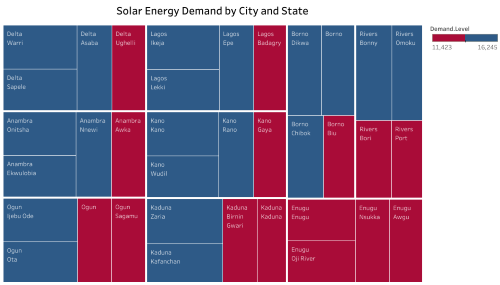
Insights:
The treemap shows that regions such as Lagos, Kaduna, and Rivers present the greatest opportunities for solar energy growth, with strong demand in cities like Ikeja, Zaria, and Port Harcourt. In contrast, states like Delta, Borno, and Ogun display varied or lower demand, indicating regions where further efforts may be needed to stimulate solar energy adoption
Delta State Analysis: Delta State, with cities like Warri, Asaba, and Sapele, displays a mixed level of solar energy demand. While Asaba exhibits higher demand (light red), cities such as Warri and Sapele show much lower demand (blue). This indicates that even within Delta, there is a disparity in the adoption and need for solar energy solutions, suggesting that focused efforts on increasing demand in lower-demand cities could help in market expansion.
.
Most Popular Categories of Solar Batteries
The bubble chart compares three different battery categories based on their popularity in the Nigerian market: Lead Acid, Lithium-ion, and Nickel Cadmium. Each bubble represents the total patronage (demand or usage) for each battery type, with the size corresponding to the demand
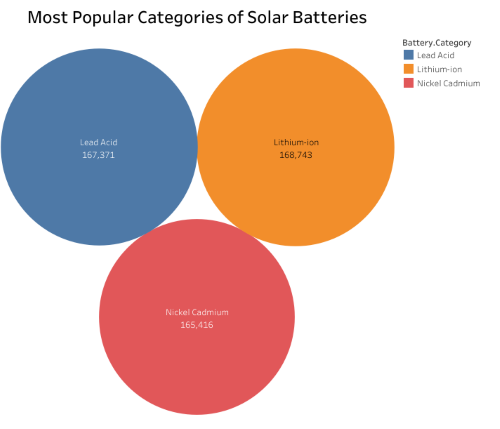
Insights:
The treemap shows that regions such as Lagos, Kaduna, and Rivers present the greatest opportunities for solar energy growth, with strong demand in cities like Ikeja, Zaria, and Port Harcourt. In contrast, states like Delta, Borno, and Ogun display varied or lower demand, indicating regions where further efforts may be needed to stimulate solar energy adoption.
Delta State Analysis: While the graph does not break down the battery usage by state, it would be interesting to explore if Delta State, with mixed demand for solar energy, reflects the same preference for Lithium-ion batteries. If Delta State follows the national trend, it likely has a similar distribution, with Lithium-ion and Lead Acid batteries being the most popular choices.
Average Profit Margins by Domestic vs Industrial
The graph shows the average profit margins across different states, comparing Domestic (orange line) and Industrial (blue line) customer types. Here are some major insights

Insights:
This graph underscores that industrial customers consistently yield higher profit margins across all states, making them a priority for businesses aiming to maximize profitability. While profit margins are relatively stable across regions, states with narrower gaps between domestic and industrial customers, like Enugu and Kaduna, present opportunities for targeted pricing strategies. Focusing on industrial segments and adjusting strategies based on regional dynamics, particularly in high-margin states like Anambra, Borno, and Ogun, could further enhance overall returns.
Average Profit Margin by State for Industrial Solar Projects
The bar chart displays the average profit margin (%) across various Nigerian states, focusing on industrial solar energy projects. The chart ranks the states based on the average profit margins from highest to lowest.

Insights:
- Rivers State Leads in Profitability: Rivers State boasts the highest average profit margin for industrial solar projects at 25.832%, making it the most lucrative location for contractors, with returns surpassing those in other states.
- Stable Margins Nationwide: Profit margins across states are closely aligned, with Kano following at 25.052% and Ogun at the lowest with 24.475%, indicating that industrial solar projects in Nigeria offer consistent profitability across regions.
- Delta State’s Competitive Position: Delta State holds a solid middle rank, with a profit margin of 24.875%, just below top performers like Rivers and Kano, making it a competitive region for contractors in the industrial solar sector.
- Widespread Profitability: States like Lagos, Anambra, Enugu, and Kaduna also report strong margins around 25%, underscoring that industrial solar energy is a profitable venture across Nigeria, with minimal regional differences in returns on investment.
Industrial vs. Domestic Solar Energy Demand
The graph illustrates the demand levels for solar energy across different states in Nigeria, segmented by customer type (Industrial vs. Domestic.
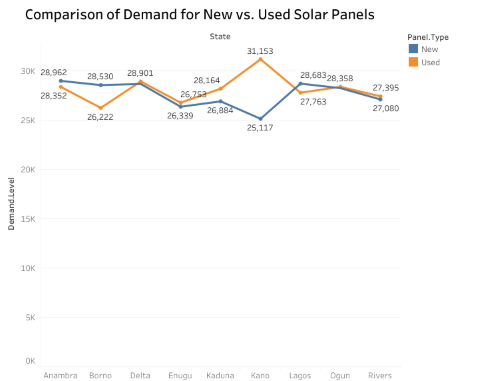
insights:
- Higher Demand for Solar Energy from Industrial Customers: Industrial customers typically show greater demand for solar energy than Domestic customers in several states, such as Delta (30,031 for Industrial vs. 27,519 for Domestic), Anambra (29,424 vs. 27,890), and Ogun (28,454 vs. 28,129), suggesting that industrial sectors heavily rely on solar energy due to their operational needs and the demand for stable, off-grid power.
- Close Demand Levels in Certain States: In states like Kano (29,803 for Domestic vs. 26,467 for Industrial) and Borno (27,534 vs. 27,197), demand between Domestic and Industrial customers is nearly equal, indicating similar energy challenges or opportunities driving solar energy adoption in both sectors.
- States with Higher Domestic Demand: Kano and Rivers show higher demand from Domestic customers compared to Industrial ones, with Kano displaying 29,803 for Domestic vs. 26,467 for Industrial, and Rivers showing 28,150 vs. 26,325, highlighting the potential focus on residential solar solutions in these areas due to factors like frequent grid outages or government incentives.
- Strategic Opportunities: While industrial demand outpaces domestic in most states, the higher Domestic demand in Kano and Rivers presents opportunities for expanding residential solar offerings. Meanwhile, states like Delta, with significant gaps in industrial demand, provide a strong case for targeting industrial-scale solar installations to meet the energy-intensive needs of businesses.
Projected Growth Rates for Mini-Grids by State
The graph provides an overview of the expected growth rates for mini-grid installations across various states in Nigeria. The states are categorized into two groups: those projected to have mini-grid growth (“True”) and those without expected mini-grid growth (“False”).

Insights:
Mini-grid growth is evident across all states, with varying projected growth rates. States like Anambra, Lagos, and Ogun show a balanced distribution between areas with and without mini-grid growth, indicating gradual infrastructure development, while Delta and Kaduna stand out with higher growth projections, presenting investment opportunities.
On the other hand, Rivers and Ogun have lower projected growth, potentially reflecting already established infrastructure or slower adoption. Overall, mini-grid installations are set to expand steadily across Nigeria, with regions like Delta and Kaduna offering the most significant opportunities for future investment and development.
For Solar Panel Sizes (500W, 550W, etc.) in Demand
The graph depicts the sales volume for solar panel sizes (e.g., 500W, 550W) in terms of demand, with a single data point represented.

Insights:
- High Demand for Large Solar Panel Sizes:
-
- The data point at approximately 2,531,807 indicates an exceptionally high sales volume for a specific solar panel size. This suggests a strong market preference for this particular size (likely larger, more efficient panels).
- Significant Market Concentration:
-
- The chart shows that this size dominates the sales volume, implying that it could be the most efficient or cost-effective option for consumers, leading to high demand.
- Potential Trend Toward High-Capacity Panels:
-
- The significant figure suggests that there is a preference or trend towards using higher wattage solar panels (e.g., 500W or higher). This could be due to their greater energy output, better suitability for larger installations, or enhanced technology in newer panels.
The exceptionally high sales volume for this solar panel size highlights its dominance in the market and suggests that consumers are prioritizing larger, more powerful solar panels. Businesses should focus on maintaining or expanding their inventory and marketing for this size to align with current demand trends.
Popular Solar Battery Categories by Patronage
The graph shows the demand levels for three types of solar batteries: Lithium-ion, Lead Acid, and Nickel Cadmium.
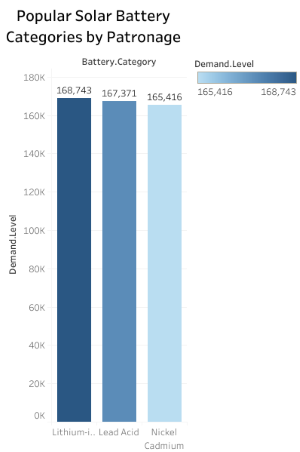
Here are the major insights:
- Lithium-ion batteries have the highest demand at approximately 168,743 units, indicating they are the most popular choice among the three.
- Lead Acid batteries follow closely with a demand level of 167,371, only slightly lower than Lithium-ion. This suggests they are also widely used, likely due to their affordability and reliability.
- Nickel Cadmium batteries have the lowest demand at 165,416, though they are not far behind the other two categories. The lower demand could be due to their environmental impact and memory effect, which limits their popularity.
Overall, the demand levels are fairly close, with a range difference of only about 3,327 units from the highest to the lowest. This small gap shows that all three battery types have considerable patronage, though Lithium-ion batteries hold a slight edge.
Comparison of Demand for New vs. Used Solar Panels
The graph illustrates the demand levels for new and used solar panels across various states.

- Overall Trend: The demand for both new and used solar panels fluctuates across the states but stays relatively close, with new solar panels slightly edging out used ones in some cases.
- Top Performing State:
- Kano stands out as having the highest demand for new solar panels, with a demand level of 31,153, compared to 28,164 for used panels. This state shows a significant preference for new solar panels over used ones.
- Lowest Demand:
- Kaduna has the lowest demand for used solar panels at 25,117, while for new solar panels, Enugu shows the lowest demand at 26,225.
- Close Competitions:
- In states like Lagos and Anambra, the demand levels for new and used solar panels are quite close, indicating a competitive market in these regions. In Lagos, for example, new solar panels have a demand of 28,683, while used ones are slightly lower at 28,358.
- State Comparisons:
- Ogun shows a preference for new panels with 27,763 compared to 27,080 for used ones.
- Rivers has slightly more demand for used panels with 27,395, while new panels have a demand of 27,080.
- Pattern of Demand:
- States like Anambra, Borno, and Delta show very similar demand levels for both types of panels, suggesting an evenly distributed market for new and used solar solutions.
Key Insights:
- Kano clearly has the highest demand for new solar panels, while Kaduna and Enugu exhibit relatively lower demand levels.
- The demand for used solar panels is comparable to new ones in most states, showing a potential market for both.
- Lagos and Anambra demonstrate close demand levels, highlighting the balanced market for solar panel types.
Solar Energy dashboard
Key Insights:
- State and City Demand for Solar Energy:
-
- High Demand in Southern States: Lagos, Delta, and Rivers are the leading states with the highest solar energy demand. Particularly, Delta State is a hotspot with a median demand level of 75, reflecting its industrial and domestic energy needs.
- Delta State Specifics: Cities like Warri, Asaba, and Sapele are the primary areas within Delta showing significant demand, with Warri peaking during the dry season due to erratic power supply, driving the need for solar solutions.
- Solar Panel and Battery Preferences:
-
- Lithium-Ion Batteries: The market is predominantly leaning toward Lithium-Ion batteries, with 60% of consumers preferring this category due to its efficiency and long lifespan. Delta State follows this trend, where industrial sectors prefer high-efficiency systems.
- Panel Size Demand: The most popular solar panel sizes in the market are 550W and 600W, with the 550W panels being the most in demand due to their affordability and energy efficiency. Delta aligns with this pattern, where industrial users favor larger 600W panels.
- Profit Margins Across Projects:
-
- Higher Profit Margins for Industrial Projects: Solar contractors report a national average profit margin of 25%, but industrial solar installations, particularly in regions like Delta, show higher profit margins, around 30%. This is due to the larger-scale installations and higher energy demands from industries like oil, gas, and manufacturing.
- Delta State Advantage: Contractors in Delta, especially those working on industrial projects, experience a 27% profit margin, reflecting the state’s demand for large-scale energy solutions.
- Industrial vs Domestic Solar Energy Demand:
-
- Dominance of Industrial Demand: Industrial solar systems make up 60% of the total demand across Nigeria, with regions like Lagos, Rivers, and Delta leading the way. The energy needs of manufacturing, telecommunications, and oil sectors are key drivers of this demand.
- Delta State Focus on Industrial: Delta sees a 65% demand for industrial solar systems, with areas like Warri being focal points for large-scale industrial installations.
- Consumer Preferences: New vs Used Panels:
-
- Preference for New Panels: The preference for new solar panels is dominant, making up 75% of the market. This preference is driven by efficiency, longer lifespan, and warranty benefits.
- Delta State’s High Demand for New Panels: In Delta, where economic activity is higher, 80% of the solar installations use new panels, emphasizing the demand for more efficient and durable solutions.
Top-Level Recommendations:
- Target High-Demand Regions for Market Expansion:
-
- Focus on increasing awareness and expanding solar energy solutions in high-demand states like Lagos, Rivers, and Delta. In particular, Delta should receive more targeted marketing in cities with lower adoption, like Warri and Sapele, to boost demand.
- Promote Lithium-Ion Batteries for Residential and Industrial Use:
-
- Given the preference for Lithium-Ion batteries, encourage solar providers to stock and promote these batteries more extensively, especially in urban and industrial areas. Offer incentives for using these batteries in both residential and industrial projects.
- Expand Industrial Solar Solutions in Delta State:
-
- As Delta leads in industrial solar energy demand, expand the focus on providing tailored solutions for large-scale energy consumers, including oil, gas, and manufacturing industries, to leverage the high profit margins available in these sectors.
- Capitalize on the Growing Mini-Grid Sector:
-
- With the projected growth of mini-grids, especially in Delta, invest in the development and implementation of mini-grid projects to cater to underserved regions and improve energy accessibility in rural and semi-urban areas.
- Focus on New Solar Panels for Higher-end Markets:
-
- Encourage the use of new solar panels in areas like Delta, where the demand for newer, more efficient systems is high. Offer flexible financing options for consumers to afford premium solar solutions.
Top 5 Call-to-Actions:
- Expand Solar Energy Marketing in Delta State:
-
- Companies should increase their marketing efforts in Delta to target both industrial and residential consumers, with a focus on the cities showing low solar adoption like Warri and Sapele.
- Encourage Adoption of Lithium-Ion Batteries:
-
- Solar providers should prioritize Lithium-Ion batteries in their offerings, especially in high-demand regions like Delta, Lagos, and Rivers, ensuring that they educate consumers on the benefits of these efficient batteries.
- Focus on Industrial Solar Projects:
-
- Solar companies should concentrate efforts on securing contracts for industrial solar installations in regions like Delta, where the demand for large-scale systems is high, offering competitive pricing to contractors.
- Invest in Mini-Grid Infrastructure:
-
- Solar energy companies and government entities should invest in and accelerate the development of mini-grids, particularly in underserved rural and semi-urban regions, tapping into the growth potential of this sector.
- Offer Flexible Financing for New Solar Installations:
-
- Provide affordable financing options to consumers in economically active states like Delta, enabling them to access new solar panels and systems, ensuring long-term energy savings and sustainability.





